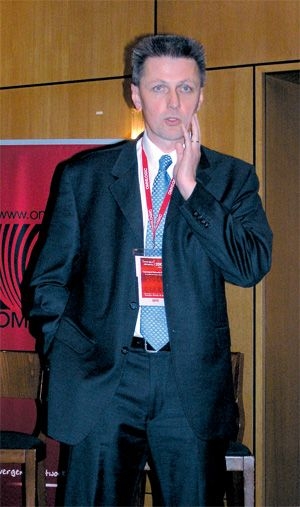
Interview with Henry Jindrich Muska, Country Manager, Airspan Czech Republic and Sales CEE, Airspan Networks
"Based on the meetings with the key players on Romanian telecommunication market we believe that WiMAX will be adopted by both fixed and mobile operators."
The list of existing Airspan traditional FWA customers in Romania includes AccessNet, 2KTelecom, Connex and Idilis.
C@M: What are the objectives of Airspan on the Romanian market?
Henry J. Muska: Romanian market is an emerging telecommunication market with already existing significant level of competition between the local wireless broadband operators. In emerging economies, the priority is to serve the urban and sub-urban communities with essential telecommunications services followed by the expansion of services to other regions. In these countries the underlying infrastructure may not be able of sufficiently high quality to enable widespread DSL deployment. WiMax solutions such as AS.MAX offer an effective answer to this need by providing a range of base stations to meet the varying requirements of urban and rural deployments as well as a range of easy to deploy and cost effective CPEs. Airspan has already deployed several FWA systems in Romania in 3.5 GHz band, and is very closely working with it's local partners. The key objective is to enlarge the base of Airspan customers in Romania, and to start deploying AS.MAX, the most comprehensive WiMAX solution. Existing Airspan deployments in Romania can be easily enhanced using AS.MAX and especially MicroMAX base stations.
C@M: Is the Czech business an Airspan regional centre for CEE? Where else in CEE did Airspan establish presence?
Henry J. Muska: Airspan has its own strategically located offices around the world, delivering pre- and post-sales product support and solutions. Airspan also has a network of partners, resellers and agents chosen for their specialist skills in the wireless telecom industry. Partnership is at the core of Airspan'™s success. Airspan has worked in partnership with many customers to implement BWA solutions in the Americas, Africa, the Middle East, Europe, Asia and Pacific Rim. We build high levels of rapport and rapid operational support into our customer relationships and augment this with a portfolio of proven management and planning tools. To be close to our customers, we use our own strategically located offices around the world. We do not believe in the 'one size fits all' philosophy; working closely with our partners enables us to stay in tune with local conditions and deliver the right solutions that meet and exceed individual needs. Czech Branch office serves as a local representative office for part of Central and Eastern Europe, which includes: Czech Republic, Slovakia, Hungary, Romania, Bulgaria, Serbia, Slovenia, Croatia, Bosnia&Herzegovina, Macedonia, Monte Negro, Cyprus and Turkey. The closest offices to Prague could be found in Warszaw, St.Petersburg or Moscow.
C@M: How do you see the potential market for WiMAX in Romania? Do you expect mobile or rather fixed operators here to adopt WiMAX? Local customers?
Henry J. Muska: WiMAX is revolutionizing the broadband wireless market by standardizing the hitherto fragmented BWA market, by opening up new service opportunities; and by creating the environment for ubiquitous broadband service everywhere. WiMAX creates a bridge between the fixed wireline and mobile cellular networks. By deploying WiMAX technology in their fixed service networks operators will be able to offer not just fixed broadband wireless services to homes and businesses but will also be able to offer nomadic and in due course, portable data services to it'™s customers. Equally, mobile operators will be able to offer nomadic and portable data services at much higher speeds than it'™s possible with voice-centric 3G networks and will be able to tariff them differently. Airspan believes that WiMAX is a very important standard for both fixed and mobile operators. Based on the meetings with the key players on Romanian telecommunication market we believe, that WiMAX will be adopted by both types of operators. In some cases the mobile operators will prioritize UMTS deployment in time. The mobile operators seem to be more active at the moment as far as WiMAX is concerned. The list of existing Airspan traditional FWA customers includes AccessNet, 2KTelecom, Connex and Idilis.
Airspan WiMAX portfolio
C@M: What are the strong points of Airspan product offering? Do you also offer support services?
Henry J. Muska: Airspan is proud to introduce AS.MAX, the industry's most complete range of WiMAX Products consisting of three different base station solutions, backhaul solutions and a range of indoor and outdoor CPEs. The AS.MAX family of products benefit from a unique combination of features, delivering the best economics and most attractive service propositions for fixed and nomadic/portable broadband access. AS.MAX is the ideal WiMAX platform on which to deploy an industry standard broadband solution. It offers all the benefits of multi-vendor interoperability, decreasing CPE costs, indoor, self install CPE economics, and a path that leads to the support of handheld device portability and roaming, thus heralding a new era of inexpensive, ubiquitous broadband wireless access everywhere. Airspan'™s WiMAX strategy is to offer a comprehensive range of solutions, enable co-existence with current products and provide the basis for seamless upgradability to IEEE 802.16e (SOFDMA) through the use of Software Defined Radio (SDR) and Adaptive Antenna Systems (AAS).
C@M: Last month the Romanian communications ministry announced it would adopt open standards in the administration. How do Airspan products fit this?
Henry J. Muska: With the arrival in 2005, defined by the IEEE, fully supported by ETSI, IEEE 802.16, WiMAX defines a world-wide open standard for broadband wireless access. WiMAX is good news for the end users, network operators, service providers and suppliers alike. WiMAX makes possible new economics as well as new performance levels, transforming the business case for deployment of broadband wireless access. It creates the necessary environment for high-quality, multi-megabit services to be delivered to end users more cost effectively by creating a global marketplace and a framework for inspiring innovation. Airspan is proud to be a founding member of the WiMAX Forum and is a member of the WiMAX Forum board. Airspan is fully committed to delivering innovative WiMAX products and services.
C@M: Could you please give an example of a city already covered with WiMAX access.
Henry J. Muska: There are currently no examples of areas covered using WiMAX technology. This is because interoperability testing, relating to this technology, has as yet not commenced.
Wireless broadband market
C@M: What are the maximum speeds and coverage of WiMAX compared to other wireless broadband technologies? How is WiMAX technology superior to UMTS-TDD from IPWireless and FLASH OFDM from Flarion?
Henry J. Muska: AS.MAX systems are optimized for the delivery of scalable services at Multi-Megabit speeds (up to 50 Mbit/s). They are comparable to fastest wireline DSL speeds, and much faster than 3G (UMTS with HSDPA and EV-DO).
C@M: In 5 years time, do you expect wireless broadband market to be dominated by WiMAX or rather by multiple standards?
Henry J. Muska: We would certainly expect the wireless local loop market to be dominated by WiMAX in five years time. However it is currently unclear as to whether this will be through the 802.16-2004 standard or the 802.16e standard.
C@M: What is the scenario of evolution/upgrading to WiMAX?
Henry J. Muska: The AS.MAX product range operates as a layer 2 bridge and as such can be seamlessly interconnected with existing Ethernet distribution technology. The management of AS.MAX is based around SNMP and a published MIB, therefore management of this network can be integrated with any other SNMP based network.





